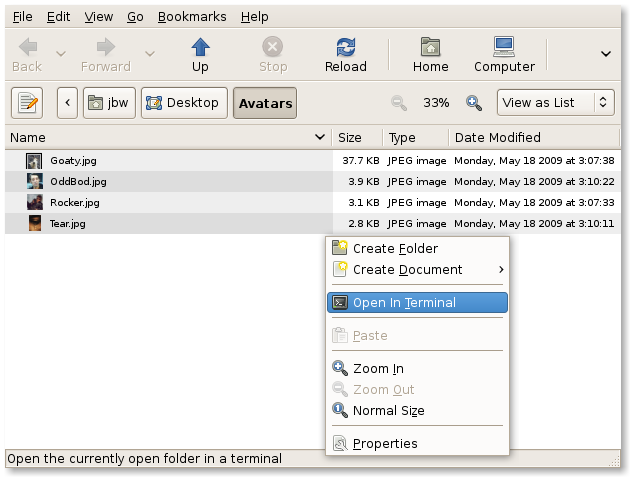
- #Nautilus open terminal how to
- #Nautilus open terminal install
- #Nautilus open terminal archive
- #Nautilus open terminal code
- #Nautilus open terminal password
This is because the nautilus command returns to the command prompt immediately. Note that there was no need for an & appended to the command line.
#Nautilus open terminal how to
Again, no subfolders to click.īut, either nearly no one has had my problem, or I can't find the right search terms.This technotes shows how to open the current project folder on Red Hat Linux with a GNONE desktop but the instructions should be applicable to any version of Unix or Linux on which RIT can be run in graphical mode and which has nautilus installed on the file path.
#Nautilus open terminal archive
Next thing, I want to archive some images based on a filename regex match. Linux: I'm browsing a recent photo dump using Nautilus previews. Going to parent folder so I have something to click on is not an option. Now I want to fire a terminal and `grep -r` (gnuwin) for a string.
#Nautilus open terminal code
Windows: Did an SVN checkout and browsing the code using GUI editors. Use cases I've had with file managers and terminals: (I personally want it only on Windows – on Linux I work in the terminal and browse on demand (`nautilus. I want to be able to right-click inside the current folder (that is, in the empty space around the icons in the folder that I'm browsing) and have a "Command prompt"/"Terminal". However, nearly all solutions target folders *inside* "/home/user/test". I sincerely believe that, while in "/home/user/test", my current folder is exactly "/home/user/test", and I want my newly opened terminal to point there. It seems there's a difference of opinions concerning which folder is the "current" one. Embed a Terminal in each Nautilus tab / window, Follows the navigation: if you navigate in Nautilus, the cd command is automatically executed in the terminal, Can be displayed / hidden using the F4 key (configurable), Configurable: font, background and text color, terminal position (displayed at top or at bottom of the windows). Still searching, however, because want to do it with registry editing. I'm into my second hour of searching about this on WinXP, and so far there's been just one tool that appears to do what I want. > "One great feature that Windows users have long enjoyed is being able to open a command prompt window to the current folder from the right click context menu when using Windows Explorer."

#Nautilus open terminal password
Click on System \ Administration \ Synaptic Package Manager from the top panel menu (when prompted, enter your password and click OK ).
#Nautilus open terminal install
Install Using Synaptic Package ManagerĪn alternative for installing nautilus-open-terminal is to use Synaptic package Manager. Note: If Open in Terminal does not appear in Nautilus, close any open programs, or applications and restart GNOME by pressing CTRL+ALT+BACKSPACE on the keyboard. Ĭlicking on it will open the current directory in a terminal window. Just right click on any directory and you should now see Open in Terminal. Once the installation has completed, enter the following command at the prompt to restart Nautilus process:Īfter running the above command, Nautilus will open automatically.

Sudo apt-get install nautilus-open-terminal Once the window opens, copy the following command to the prompt and press Enter (you will be asked to enter your password when prompted): Just click on Applications \ Accessories \ Terminal.

The easiest method is to install from a terminal window.


 0 kommentar(er)
0 kommentar(er)
